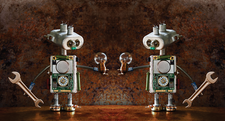Simulate Raspberry Pi add-on hardware
Soft Pi

© Lead Image © Author, 123RF.com
Python and tk_tools let you create software versions of Raspberry Pi mini-displays, LED keypads, and NeoPixel hardware.
Raspberry Pis have some great hardware options for displaying information or accepting input. You can use either specialty plates that mount directly on top of the Rasp Pi or a variety of wired components.
Although nothing beats using real hardware for projects, if you're missing the hardware or you'd like to duplicate a value remotely, then a soft version of the hardware can be very useful. In this article, I look at three examples of hardware simulated with the help of Python and the tk_tools Python library [1]: a seven-segment wired display, an LCD keypad, and a NeoPixel string.
Seven-Segment Display
A seven-segment display uses seven horizontal and vertical bars, familiar in clocks, meters, and other electronic devices, to represent numbers and letters. The displays are often based on the HT16K33 [2] or TM1637 [3] chipset (Figure 1).
[...]
Buy this article as PDF
(incl. VAT)
Buy Linux Magazine
Subscribe to our Linux Newsletters
Find Linux and Open Source Jobs
Subscribe to our ADMIN Newsletters
Support Our Work
Linux Magazine content is made possible with support from readers like you. Please consider contributing when you’ve found an article to be beneficial.

News
-
Another Linux Malware Discovered
Russian hackers use Hyper-V to hide malware within Linux virtual machines.
-
TUXEDO Computers Announces a New InfinityBook
TUXEDO Computers is at it again with a new InfinityBook that will meet your professional and gaming needs.
-
SUSE Dives into the Agentic AI Pool
SUSE becomes the first open source company to adopt agentic AI with SUSE Enterprise Linux 16.
-
Linux Now Runs Most Windows Games
The latest data shows that nearly 90 percent of Windows games can be played on Linux.
-
Fedora 43 Has Finally Landed
The Fedora Linux developers have announced their latest release, Fedora 43.
-
KDE Unleashes Plasma 6.5
The Plasma 6.5 desktop environment is now available with new features, improvements, and the usual bug fixes.
-
Xubuntu Site Possibly Hacked
It appears that the Xubuntu site was hacked and briefly served up a malicious ZIP file from its download page.
-
LMDE 7 Now Available
Linux Mint Debian Edition, version 7, has been officially released and is based on upstream Debian.
-
Linux Kernel 6.16 Reaches EOL
Linux kernel 6.16 has reached its end of life, which means you'll need to upgrade to the next stable release, Linux kernel 6.17.
-
Amazon Ditches Android for a Linux-Based OS
Amazon has migrated from Android to the Linux-based Vega OS for its Fire TV.

